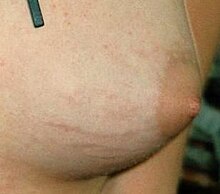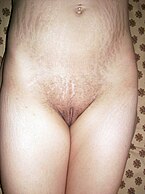Stretch marks
| Classification according to ICD-10 | |
|---|---|
| L90.6 | Striae cutis atrophicae |
| ICD-10 online (WHO version 2019) | |
Stretch marks are visible phenomena in the subcutis , which are caused by excessive stretching of the tissue. In medical terminology, the stretch marks of the skin are referred to as Striae cutis atrophicae or Striae cutis distensae (literally 'strips of the atrophic skin' or 'strips of the stretched-apart skin'; from Latin stria 'groove, depression, strip' , cutis 'skin' , adjective formation to atrophia , lessening the diet, emaciation, wasting, atrophy ' and past participle Nebenform distensus to distendere apart stretch, stretch' ), respectively. During pregnancy, the appearance of stretch marks is physiological; they are referred to as stretch marks ( latin striae gravidarum , the pregnant strip ' with genitive plural of gravida , pregnant' ), respectively.
Striae gravidarum
The color is caused by translucent blood vessels , hence the name Striae rubrae (from Latin ruber = red).
Affected body regions
The stripes tend to occur on particularly heavily stressed tissues such as the abdomen , hips , buttocks , upper arms and breasts . Predisposing factors are a weak connective tissue and a strong weight gain. In addition, the skin's elasticity is reduced during pregnancy due to hormonal influences.
Emergence
The connective tissue in the dermis, which is responsible for the elasticity of the skin, consists of a network of collagen fibers . If the connective tissue is overstretched, this leads to irreparable tears in the subcutaneous tissue, which lead to externally visible reddish blue stripes. Over time, the streaks fade but remain visible as light-colored scars.
Stretch marks not only appear during pregnancy, they can also show up with cortisone therapy or as you grow. It is also possible to get stretch marks from too much exercise. Women with medium to large breasts can wear a sports bra when exercising to counteract these streaks. Likewise, when building more muscle (like bodybuilding ), stretch marks are almost inevitable.
In addition, stretch marks can be symptoms of diseases, such as obesity or Cushing's syndrome , or they can arise as a side effect of medication, for example during therapy with adrenocorticotropic hormone (ACTH) and glucocorticoids .
prevention
Studies have not shown any preventive effectiveness of topical creams or lotions.
treatment
Vitamin A acid in creams or orally ingested can positively influence the scars regression. However, because of its teratogenic effect, vitamin A acid (tretinoin) must not be used during pregnancy. Vitamin A acid must not be taken or applied to the breast area during breastfeeding.
There are also methods available that enable a reduction in size or, in the case of hypertrophic (protruding; bulging) scars, a flattening, e.g. B. cryotherapy , topical application of trichloroacetic acid and various laser systems .
literature
- M. Tunzi, GR Gray: Common skin conditions during pregnancy. In: Am Fam Physician. 2007 Jan 15; 75 (2), pp. 211-218. Review. PMID 17263216
- S. Alaiti et al: Striae Distensae. www.emedicine.com - Article Last Updated: Jul 24, 2007
Web links
- Striae Distensae at www.dermis.net
Individual evidence
- ^ Karl Ernst Georges : Comprehensive Latin-German concise dictionary . 8th, improved and increased edition. Hahnsche Buchhandlung, Hannover 1918 ( zeno.org [accessed on August 13, 2020] dictionary entry 'stria').
- ^ Karl Ernst Georges : Comprehensive Latin-German concise dictionary . 8th, improved and increased edition. Hahnsche Buchhandlung, Hannover 1918 ( zeno.org [accessed on August 13, 2020] dictionary entry 'cutis').
- ^ Karl Ernst Georges : Comprehensive Latin-German concise dictionary . 8th, improved and increased edition. Hahnsche Buchhandlung, Hannover 1918 ( zeno.org [accessed on August 13, 2020] dictionary entry 'atrophia').
- ^ Karl Ernst Georges : Comprehensive Latin-German concise dictionary . 8th, improved and increased edition. Hahnsche Buchhandlung, Hanover 1918 ( zeno.org [accessed on August 13, 2020] dictionary entry 'distendo' (not the infinitive, but the first person singular indicative present active as usual in Latin)).
- ^ Karl Ernst Georges : Comprehensive Latin-German concise dictionary . 8th, improved and increased edition. Hahnsche Buchhandlung, Hannover 1918 ( zeno.org [accessed on August 19, 2020] dictionary entry 'gravidus').
- ↑ Miriam Brennan, Gavin Young, Declan Devane: Topical preparations for preventing stretch marks in pregnancy . In: Wiley (Ed.): Cochrane Database of Systematic Reviews . November 14, 2012, ISSN 1465-1858 . doi : 10.1002 / 14651858.cd000066.pub2 .



